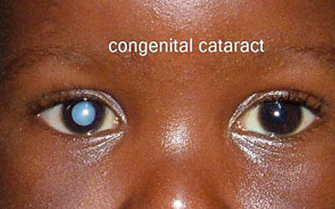CONGENITAL CATARACTS
 A congenital cataract is an opacity (cloudiness) in the lens of the eye that is present at, or develops shortly after, birth. The human lens is located behind the pupil and has an important function. It focuses rays of light into the retina to allow image formation. As the lens is able to change is shape, it can focus objects at different distances. Its cells are arranged so that it is transparent, like the lens in a camera. When this arrangement is disturbed in any way, the transparency is lost and an opacity results. This results in blurring and blocking of the retinal image. In the case of a newborn infant, a cataract causes the immature visual system to be deprived of the stimulation needed for normal development. If left untreated, permanent visual loss (lazy eye) may occur.
A congenital cataract is an opacity (cloudiness) in the lens of the eye that is present at, or develops shortly after, birth. The human lens is located behind the pupil and has an important function. It focuses rays of light into the retina to allow image formation. As the lens is able to change is shape, it can focus objects at different distances. Its cells are arranged so that it is transparent, like the lens in a camera. When this arrangement is disturbed in any way, the transparency is lost and an opacity results. This results in blurring and blocking of the retinal image. In the case of a newborn infant, a cataract causes the immature visual system to be deprived of the stimulation needed for normal development. If left untreated, permanent visual loss (lazy eye) may occur.
Causes for Congenital Cataract
Any disruption of the normal structure of the lens can result in clouding. This could be caused by a) accumulation of abnormal breakdown products (metabolites) with retention of water within the lens or b) by interruption of normal development of the lens by a genetic error or an environmental agent. Among these infective agents (in particular viruses) radiation and drugs could be on occasions implicated as causative. In our country infection of pregnant ladies with Rubella virus & consanguineous marriages ( marriages within the relatives ) are the most common causes. The chance of having a congenital cataract is particularly high if there is a family history.
Effects of the Condition
If the cataract is small there may be only slight blurring of vision with near normal visual development. Frequently, though, the impairment is more severe and can lead to permanent amblyopia (lazy eye or underdevelopment of the visual system). Without adequate stimulation central vision can be permanently impaired. Some peripheral vision usually remains and the eye does not usually lose the ability to distinguish light and dark. Congenital cataracts can affect one eye only or both eyes. In bilateral cases the cataract may be denser in one eye than the other. If the image is less blurred in one eye as compared to the other, this eye will develop vision preferentially, with additional suppression of visual development in the other eye.
Treatment
Removal of the cataract via surgical extraction of the lens is the most effective means of treatment for most cataracts. Optical correction with a contact lens and/or glasses is usually necessary. Intraocular lenses are becoming more commonly used in young children. However they cannot be implanted in very young children as they eye ball is small in size & still growing. Because a clear visual axis is essential for early visual development, a diagnosis within the first few weeks of life is important. Surgery has to be done as early as possible to improve the chances of maximum visual recovery. Cataract surgery in a child is technically more difficult than in an adult & should be performed only by a surgeon with adequate experience in pediatric cataract surgeries. If surgery to one eye only is required, an optimal outcome is only possible by patching the healthier eye for several hours a day in early childhood.
Prognosis
The eventual outcome is very much dependent on the type of cataract & the timing of surgery. Some congenital cataracts impair visual development only to a small degree and may never require surgery. If the cataract is in one eye only (unilateral) there is a strong tendency for the child to prefer the healthy eye so that the eye affected by the cataract rarely achieves normal vision. However, in bilateral cases the vision may, in some cases, eventually become near normal if complications are avoided. As the treatment often requires an operation, late complications may occur.Most prominent among these, are increases in intraocular pressures (Glaucoma) with subsequent optic nerve damage and visual loss due to retinal detachment. So the bottom line is early diagnosis & treatment is the key to successful visual rehabilitation in congenital cataracts.

